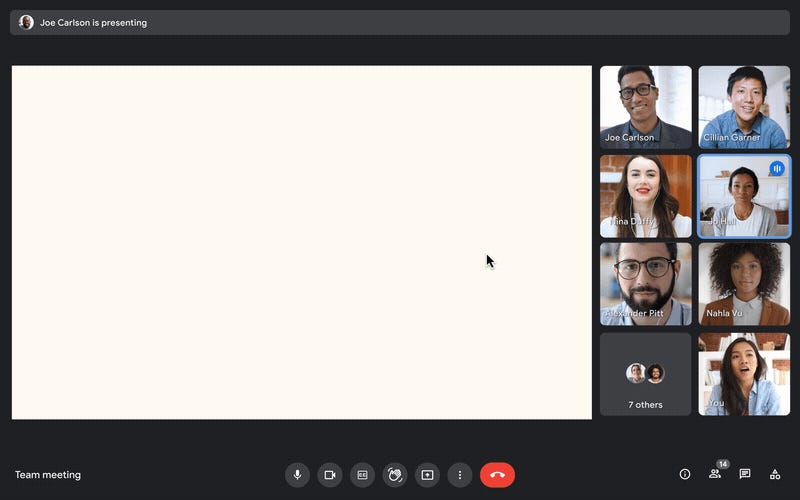
Starting in April, Google Meet attendees will be able to react in meetings with emojis like a thumbs-up or heart emoji.
GoogleGoogle on Wednesday announced its latest round of updates to Workspace, its productivity and collaboration platform, including expanded encryption options for Google Meet videos. Additionally, Google is also to let customers directly integrate Meet videos into Google Docs, Sheets and Slides. This integration will let users see their collaborators — plus the documents they’re collaborating on — all under one tab.
Google started quickly rolling out a number of new and improved features to its collaboration tools a couple of years ago when the Covid-19 pandemic made virtual work an imperative. Since then, Google has also stepped up efforts to integrate all of its tools.
With all of its communication and collaboration products integrated into one suite, “we’re of course making major bets on Google Docs and Google Sheets as storage vehicles for all sorts of things,” Google’s Dave Citron said to reporters this week. “We’re able to store all the artefacts from a meeting using Google Docs, Sheets, Slides, etc. All of it gets magically indexed by the Workspace search engine, so you’ll be able to search across all of it in one seamless way.”
Improved security is a critical component of Google’s strategy — businesses won’t embrace collaboration or storage tools that leave their content vulnerable. To that end, Google is bringing optional end-to-end encryption for Google Meet meetings to all Google Workspace customers.
Additionally, in May, certain customers will have access to client-side encryption (CSE) in Meet. This feature, which is currently in beta, gives customers direct control of the encryption keys and identity provider used to access those keys. CSE in Meet will be available for customers on Business Plus, Enterprise Plus, and Education Plus Workspace plans.
Meanwhile, the ability to add Meet videos directly into Docs, Sheets and Slides will be in GA in the coming weeks. Users will be able to start a meeting and bring it to a document, spreadsheet or presentation. This will allow all meeting participants to collaborate while having a conversation.
Google Docs “pioneered” real-time collaboration, Citron said, and this new capability will “convert that magical co-authoring experience to a real-time video call.”
Some of the new Google Meet features announced Thursday mimic features included on other videoconferencing platforms like Zoom. For instance, next month, attendees will be able to react in meetings with emojis like a thumbs-up or heart emoji. Meet next month will also offer picture-in-picture capabilities for users running Chrome browsers. They’ll be able to see up to four video tiles of meeting attendees in a floating window on top of other applications.

Google also announced improvements to Meet’s livestreaming features. Currently, Google Meet users can host meetings of up to 500 active attendees with the ability to livestream to audiences of up to 100,000 across trusted Google Workspace domains. Coming later this year, livestream attendees will be able to participate in Q&A and polls. Additionally, later this year, Google will enable meeting hosts to stream meetings directly to YouTube from the Meet activities tab.
There are also coming improvements to Companion mode, which first rolled out to Google Meet in November. Companion mode allows users to host or join a meeting from within a conference room using their laptops while leveraging the in-room audio and video. This makes it easier to share content, see presentations up close or use other features just as remote attendees do. To improve the in-room experience, Google started rolling out automatic noise cancellation on all Google Meet hardware, including Logitech, Acer and Asus hardware. Later this year, people in conference rooms will also be able to add their own personal video tile from Companion mode and their laptop cameras.
Google is also adding improvements to Spaces; the Workplace tool introduced last year. Spaces allow for real-time collaboration across projects and topics and across different modalities, including email, Chat, and Meet. A conversation could, for instance, start in email but move to a more collaborative space like Meet.
Spaces will offer inline threading in the coming weeks — a top request from enterprise customers. Google is also making Spaces more sharable and discoverable. Last week the company enabled users to invite others to join a Space via a shared link, and later this year, they will enable users to search and join Spaces across an organization. They’re also improving search within Chat and Spaces to surface relevant files and conversations. Google is also increasing the team size limits of Spaces from 400 to 8,000. It will increase to 25,000 by the end of this year.






















